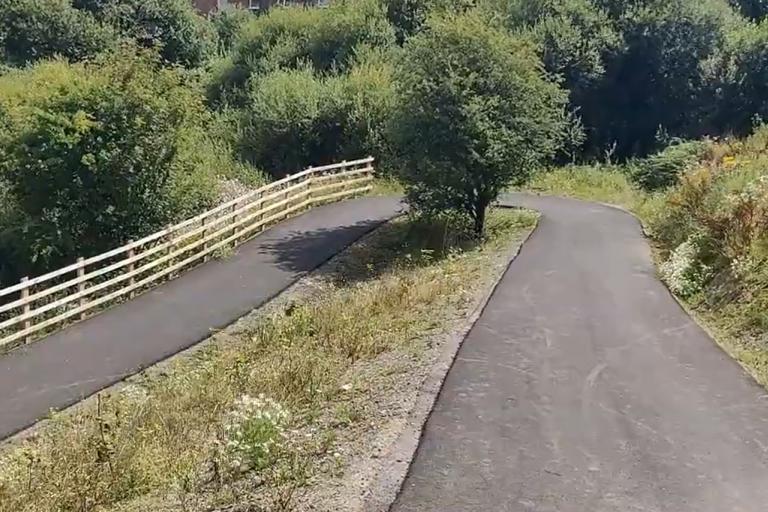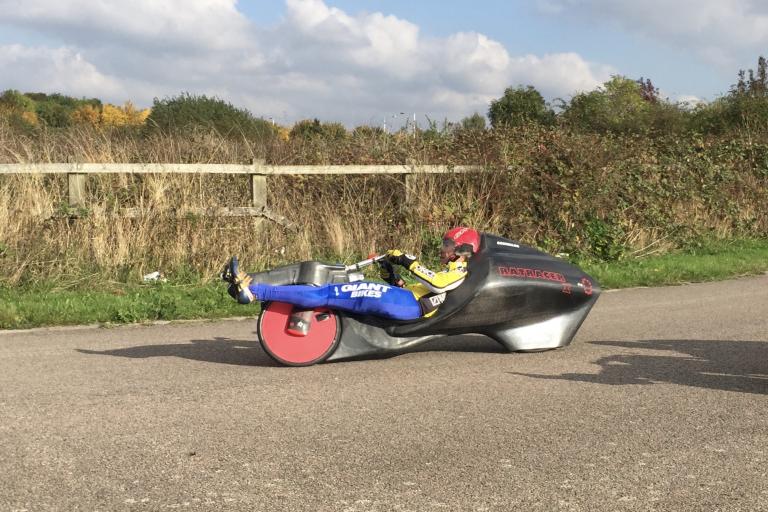- News
- Reviews
- Bikes
- Components
- Bar tape & grips
- Bottom brackets
- Brake & gear cables
- Brake & STI levers
- Brake pads & spares
- Brakes
- Cassettes & freewheels
- Chains
- Chainsets & chainrings
- Derailleurs - front
- Derailleurs - rear
- Forks
- Gear levers & shifters
- Groupsets
- Handlebars & extensions
- Headsets
- Hubs
- Inner tubes
- Pedals
- Quick releases & skewers
- Saddles
- Seatposts
- Stems
- Wheels
- Tyres
- Tubeless valves
- Accessories
- Accessories - misc
- Computer mounts
- Bags
- Bar ends
- Bike bags & cases
- Bottle cages
- Bottles
- Cameras
- Car racks
- Child seats
- Computers
- Glasses
- GPS units
- Helmets
- Lights - front
- Lights - rear
- Lights - sets
- Locks
- Mirrors
- Mudguards
- Racks
- Pumps & CO2 inflators
- Puncture kits
- Reflectives
- Smart watches
- Stands and racks
- Trailers
- Clothing
- Health, fitness and nutrition
- Tools and workshop
- Miscellaneous
- Buyers Guides
- Features
- Forum
- Recommends
- Podcast
news
Taxi driver “celebrates” bike lane removal – by close passing cyclist; Council blasted for ripping up bike lane, so cars can park on path; “If cyclists really need a safe space, a painted lane would suffice”; “Cycle freaks” slated + more on the live blog
SUMMARY
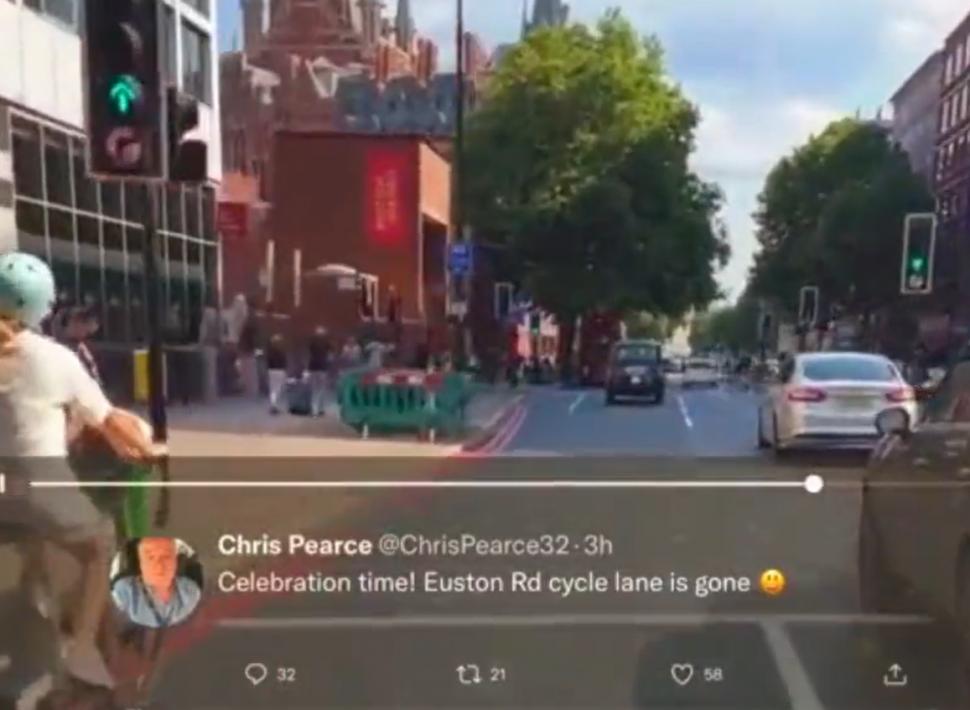 Taxi driver 'celebrates' removal of Euston Road cycle lane (Jeremy Vine, Twitter)
Taxi driver 'celebrates' removal of Euston Road cycle lane (Jeremy Vine, Twitter)16 August 2022, 16:29
“No cycle lane is much better than the sort of cycle lane that endangers a cyclist”: Reader reaction
Bristol 24/7’s Martin Booth’s claim that “even a crap cycle lane is better than no cycle lane at all” – after Bristol City Council decided to take out the bike lanes on the city’s Cheltenham and Ashley roads – hasn’t gone down too well with some of our readers.
BalladOfStruth wrote: “No cycle lane is much better than the sort of cycle lane that endangers a cyclist – this goes double if the offending cycle lane is within good view of the main carriageway so drivers then punish you for not using it.”
“I live near that junction and to be honest, I'd forgotten there was even a cycle lane there,” says Bmblbzzz. “That's how useful it was. And the pavement did (still does, really) need widening, especially right on the corner by the credit union.
“Which isn't to say there haven't been missed opportunities – I'm disappointed that you still can't (legally and/or easily) turn right out of Nine Tree Hill – but I do think replacing that particular painted lane (and let's remember it's not long ago it was fashionable to call it a "moord strip" – not sure if I've spelled that right) with pavement was probably a good decision. Might have been better if they'd made the road one lane only inbound at the same time.”
hawinspeter agreed, writing: “I often cycle along Cheltenham Rd and turn down Ashley Rd and the cycle paint was absolutely useless as there'd invariably be taxis parked across it.
“I tend to use that route late at night, which means that there's drinkers spilling out from the bars and over the cycle lane too. They should just restrict motor vehicles to just one lane along there and have wider pavements and protected cycle lanes too.”
On the subject of Bristol’s position as a ‘cycling city’, brooksby said: “Bristol has a lot of cyclists, and still has a strong 'cycling culture' (even after Roll for the Soul and Bristol Bicycles closed, and after the council closed the Chocolate Path and never reopened it), but it is never been a 'cycling city' in the time I've been actually cycling there.
“But the city council really couldn't give a monkey's about cycling anyway. They are much happier with gimicky 'green initiatives' which are whizz-bang and hi-tech.”
“I agree,” wrote ShutTheFrontDawes. “I cycled every day to college at the college green campus in the mid noughties, and I can see why the city earned its 'cycling city' status.
“With bike lanes (or in many cases nice wide bus lanes, with good parking enforcement) and advanced stop lines on most major routes, it was a real step up from what came before.
“Times change though; population density has increased while public transport provision hasn't improved, and more people are in their cars. The cycling provisions in Bristol are now below par when I compare it to my experience of other UK cities.”
16 August 2022, 15:53
Russell Crowe spotted cycling in Bray
Bray, in Co. Wicklow, is one of Irish cycling’s holy places (and also where this writer spent quite a few of his childhood summer holidays).
Two-wheeled heroes who honed their talents on the roads around the coastal town south of Dublin include the pioneer Shay Elliott, Peter Crinnion, Peter Doyle, and now Russell Crowe, apparently.
My photos show actor @russellcrowe really enjoying his down time in Bray,Co.Wicklow over the last couple of days… pic.twitter.com/r7WiGs5Dvz
— Padraig O'Reilly Photographer (@padraig_reilly) August 12, 2022
The Gladiator star, who has been known for getting out and about on his bike in the past (sometimes without a shirt), is currently in Bray filming a new supernatural thriller called The Pope’s Exorcist (sounds… great).
He was spotted over the weekend putting the miles in while on a break from filming, taking advantage of both the sunshine and the town’s pretty decent cycling infrastructure. Thankfully, Crowe was wearing a shirt this time…
16 August 2022, 15:39
16 August 2022, 15:11
Airbnb encourages locals to cash in on UCI Road World Championships coming to town
As someone who was kicked out of his student flat to make way for a family of wealthy Americans heading to the Open Golf Championship, I’m well aware of the lucrative potential of international sporting events for those with a bed going spare.
So, I wasn’t that surprised to hear that Airbnb, the online lodgings marketplace, are encouraging residents of Wollongong, New South Wales, to cash in during next month’s UCI road world championships in the area.
With event organisers and local officials predicting an accommodation shortage at the week-long cycling festival, and with many race-goers potentially forced to stay an hour away in Sydney, Airbnb is “encouraging residents to share their home to help their city handle the increased demand for accommodation, as competitors, organisers, media and spectators descend on the region for one of the biggest weeks on the Australian sporting calendar.”
According to the American company, hosts could pocket around $1,000 – almost equalling the median Australian household’s weekly income – if guests book for four nights during the races.
> UCI Road Worlds to force Aussie schoolkids out of classroom and back online
“Hosting on Airbnb is a great way to help showcase Wollongong’s beautiful natural surrounds and highlight the region to help make this important local event a success, while also creating an opportunity to earn extra income to combat the rising cost of living,” said Susan Wheeldon, Airbnb’s Country Manager for Australia and New Zealand.
“Airbnb offers a unique opportunity for communities in and around Wollongong to be a part of history during the first cycling World Championships held in Australia in over a decade.
“Home sharing helps cities use existing space to scale up their capacity and welcome major events like this. It also empowers locals to provide sustainable and affordable accommodation across the city, benefitting the local economy.
“Hosts on Airbnb play a valuable role in making guests feel extremely welcome and our Wollongong Hosts are no exception as they help to point guests in the direction of the best hidden gems and local businesses to support.”
16 August 2022, 14:38
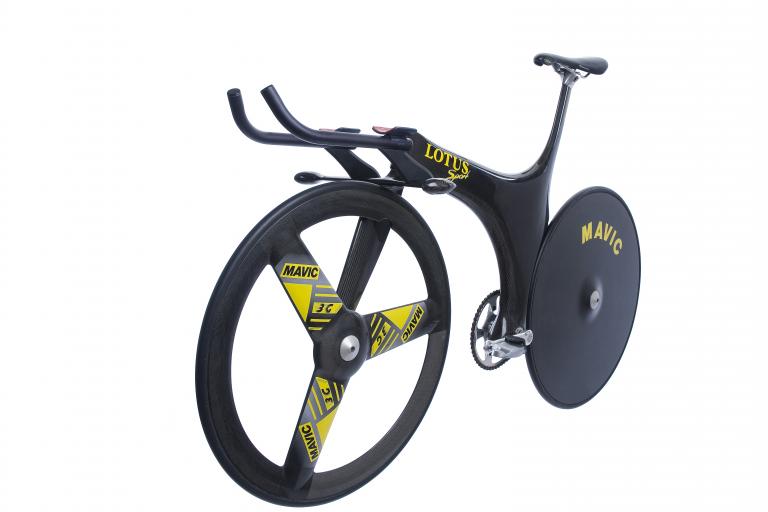
“A true visionary”: Lotus pays tribute to Mike Burrows
Lotus has paid tribute to legendary Norfolk-based bike designer Mike Burrows, who died this week, aged 79.
Burrows famously collaborated with the automotive company on what became the Lotus 108, one of the most iconic and ground-breaking bikes ever built, most famously used by Chris Boardman on his way to pursuit gold at the Barcelona Olympics thirty years ago.
> "We shall never see his like again": Remembering Mike Burrows
Richard Hill, chief aerodynamicist at Lotus who worked closely with Mike on the development of the Type 108, said today: “I’m so very sad to hear this news.
“Mike was a true visionary, way ahead of his time. Without his original concept for a monocoque frame, the Type 108 would never have come into existence.
“Mike thought beyond any rules – he was a ‘what if…?’ man – and was famous for transforming his ideas into reality, riding and testing them himself. It was privilege and honour to work with him during the early development of the 108.
“Focused, determined and single-minded, he would always come up with a solution to any problem. A talented engineer, his place in the history of cycling is secured.”
16 August 2022, 13:57
Anti-LTN campaigner shows his distaste for LTNs… by enforcing them
The irony here. He’s patrolling a LTN, stopping drivers going through it, therefore enforcing it. He’s anti LTN, thinks they’re just money grabbing schemes. And the topper…he’s riding a bike 😂😂😂 pic.twitter.com/ahl34FEheu
— Richard S (@Stokesy1966) August 15, 2022
My head hurts reading that…
16 August 2022, 13:40
Now, this is the kind of cycling infrastructure I want…
16 August 2022, 13:25
“Biking Bargains” at Lidl: To the middle aisle we come!
It’s that time of the year again, folks, when Quick Step-Alpha Vinyl’s former sleeve sponsor fills up their famous middle aisle with lots of bike-related stuff (and some items I’ve never seen before in my life).
This year’s collection includes helmets, pumps, a lights set, a work stand, ceiling rack, backpacks, saddles, water bottles, groovy mid-noughties era sunglasses, and what looks like a swimming cap but Lidl says is actually a helmet rain cover.
Oh, and this is excellent bike basket for the dog in your life who just loves going for a spin:
They see me rollin’ 😎 pic.twitter.com/qrClU6dgKm
— @LidlGB (@LidlGB) August 14, 2022
16 August 2022, 12:51
Some tips for how to deal with that strange liquid that’s recently started to fall from the sky when you’re out on the bike…
It's been so long since that wet stuff fell from the sky, some of us #cyclists may have forgotten how to ride in it! Without further ado, here are your top tips for riding in the rain... https://t.co/GzeUXr3tjD #cycling pic.twitter.com/vrNAPpkQxs
— road.cc (@roadcc) August 16, 2022
16 August 2022, 12:28
16 August 2022, 12:13
Bernal’s back on the bus... and in the peloton
Ready to race!
Amazing to have Egan back on the bus. Let's get #PNDKR22 started 👊🇩🇰 pic.twitter.com/V5CLTnSuGh
— INEOS Grenadiers (@INEOSGrenadiers) August 16, 2022
"Hey Egan, fancy towing us along in your first race back? Cool cheers mate"#PNDKR22 pic.twitter.com/210jUZLC5c
— Dan Deakins (@DanDeakins) August 16, 2022
16 August 2022, 11:35
London taxi driver “celebrates” removal of bike lane – by close passing cyclist
I sense a pattern emerging on the live blog today…
With the temporary cycle lane on London’s Euston Road now removed (thanks, Transport for London says, to “increased traffic congestion” in the area), one taxi driver decided to mark the occasion by posting a Twitter video captured on his dashcam, with the caption: “Celebration time!”
Unfortunately for the cabbie, the clip also clearly shows him – ironically enough – committing a close pass on a cyclist… Oops.
London cab driver @ChrisPearce32 “celebrates” the removal of the Euston Road cycle lane by close-passing a cyclist, thereby proving why it was needed.
@MikeyCycling @willnorman @WeAreCyclingUK @London_Cycling @betterstreetskc @loled1967 @steaminelle @bike_rogers @righttobikeit pic.twitter.com/wSrdghJHZS— Jeremy Vine (@theJeremyVine) August 16, 2022
After the now-deleted video was reposted on Twitter this morning by Jeremy Vine, the cab driver in question defended the overtake, which he says was “easily 1.5m away from the cyclist”:
In the so called close pass I was easily 1.5m away from the cyclist and travelling at a speed relative to her of about 2mph. You all need to calm down.
— Chris Pearce (@ChrisPearce32) August 16, 2022
That rather tenuous excuse hasn’t washed, however, not only with two-wheeled activists like CyclingMikey, but also with the driver’s fellow cabbies:
You were within roughly 2 feet of her, and you stayed in the same lane. Why couldn't you drive as beautifully as the taxi in front of you did? That was how you should pass such cyclists.
— CyclingMikey (@MikeyCycling) August 16, 2022
Fellow cabbie here. This pass here was an atrocious piece of driving from a professional driver. I’d report such myself if I’d caught on my dash cam pic.twitter.com/dfakOiWFh7
— MysticKrow (@KrowMystic) August 15, 2022
For some reason, those responses haven’t kept the driver from digging ever deeper:
Hello Jeremy, love your show. This video shows that appearances can be deceptive. I’m 1m away from the cycle lane although I appear to be almost in it. The Euston Rd cycle lane was a disaster for cyclists as well as motorists and needed replanning. pic.twitter.com/FpsMFWfdxP
— Chris Pearce (@ChrisPearce32) August 16, 2022
Not the same though, the video posted by @theJeremyVine shows both the cyclist and the cab driver being in the same lane during the overtake. The lane looks to be of similar width to the lane in your video, just without the cycle lane.
— Pauric (@pward82) August 16, 2022
Somebody even got the calculator out:
Let me do the maths for you...
Lane width (at overtake point): 300cm
LEVC TX taxi width: 203cm
Lime bike width: 60cm~37cm~ is the space you left between your vehicle and the cyclist pic.twitter.com/UYFmuo4TYi
— swcyclist (@swcyclist) August 16, 2022
The self-incriminating taxi driver, rather than hold his hands up, has continued to double down on his mistake by posting a series of anti-cycling videos on his Twitter account this morning and changing his profile photo to one of himself (presumably) in cycling clothing.
Give it up, fella…
16 August 2022, 11:01
Bring back the 1990s! What could possibly go wrong?
— Tim - UllrichsErben 🇩🇪 (@ullrichserben) August 15, 2022
Ah, don’t you just love to see some nostalgia for the days when Claudio Chiappucci would take off up the road with just 250 kilometres and the Col des Saisies, Col d’Iseran, Cormet de Roselend, Mont Cenis, and Sestriere to go?
Ah, those long, hot summer days when jerseys were baggy, riders were helmet-less, and team-sanctioned doping was rampant (before such practices were completely and categorically eradicated in 2008, of course). Bliss.
16 August 2022, 10:53
16 August 2022, 10:17
Christ on bikes
— CycleSystemsOnline (@CycleSystemsAc) August 16, 2022
road.cc reviewer Mike Stead, however, has some notes for Jesus’ next bike-related sermon:
Correction: “You don’t really need disc brakes IF you have large, strong hands, ride in a sunny, flattish place with nice roads on skinny tyres, are willing to risk poor wet weather performance & can afford to replace brake cables/buy new wheels every few years”
Agree 100% 👍🏻 😎
— Mike Stead (@tweetymike) August 16, 2022
16 August 2022, 09:57
‘I never had any issues parking illegally until you cycle freaks came along’: More drivers parking on cycle lanes…
Yet another example (it’s been a long morning) of a motorist parking in a cycle lane, on the pavement, and on double yellow lines. Oh, and with an illegal number plate thrown in for good measure:
Illegal number plates, obstruction, double yellows and the driver pops up in the comments defending their offending ... Quality 😂 👍 https://t.co/B2Ni8WL74L
— Mark Hodson (@markandcharlie) August 14, 2022
The car owner’s now-deleted reply has lots of Scooby Doo villain energy, I’ll give her that:
Have they deleted the tweet where they admit to intentionally and persistently parking on the DYL and violating planning rules by building a driveway with no dropped kerb permission? pic.twitter.com/W37Q9X213f
— James Thorniley (@JamesThorniley) August 13, 2022
“And I would have gotten away with it too, if it weren’t for you meddling cycle freaks”…
16 August 2022, 09:40
16 August 2022, 08:53
“How can removing cycle lanes ever be justified?” Council blasted for getting rid of bike lane… so motorists can “park on pavement more easily”
Fantastic to see drivers being able to park their cars more easily on the wider pavements on Cheltenham Road, and no cycle lane to get in their way any more either pic.twitter.com/gU2wrv6MC5
— Martin Booth (@beardedjourno) August 13, 2022
We head south now for the second of today’s ‘councils and bike lanes’ bonanza, as Bristol City Council comes under fire for after a cycle lane was removed in favour of a wider footpath which, in the eyes of one local observer, has just made it “easier for cars to park”.
In an article for the news site Bristol 24/7, editor Martin Booth has blasted the council’s decision to remove the bike lane on the Cheltenham Road towards the junction with Ashley Road.
“It was of poor quality and in desperate need of improvement,” Booth admits of the now-vanished piece of bike infrastructure. “But it was still a cycle lane.”
Booth notes that the recent ‘improvements’ to the junction – which the council even admitted might prove “contentious” – have resulted in a wider pavement, which according to the writer has not improved pedestrian safety but simply allowed motorists to park their cars more easily.
“At the newly remodelled Ashley Road junction,” he writes, “early release signals for cyclists in the advanced stop lane (ASL) are all well and good – but a gauntlet of parked cars usually has to be navigated in order to get there, which are as unsafe for pedestrians as they are for cyclists.”
The changes on the Cheltenham Road follow the decision to rip out the cycle lane on the Whiteladies Road – a key route into Bristol city centre – after the council claimed that the lane “causes flooding”. However, as we reported in May, opposition councillors and environmental campaigners in response to the council’s decision pointed out that blocked drains were, in fact, the real source of the problem.
> Key Bristol cycle lane to be scrapped – because council claims it causes flooding
According to Booth, the extended works on the Ashley Road “have mostly just moved the crossings by a few metres, widened a few short stretches of pavement and removed a cycle lane: all seemingly for the benefit of car drivers… By widening the footway, all it has done is make it easier for cars to park. And I have yet to see the double-yellow lines ever be enforced.”
There used to be a cycle lane that went from Tesco to the junction of Ashley Road. Even a shit cycle lane is better than no cycle lane at all. Removing cycle lanes is not a good look. Bristol’s days as the UK’s first ‘cycling city’ are long gone. pic.twitter.com/xZ6PqcBdgu
— Martin Booth (@beardedjourno) August 9, 2022
Toby Wells, from Bristol Cycling Campaign, agreed with Booth’s take and said that the group was “really disappointed that the opportunity wasn’t taken to revamp the junction for cycling whilst doing all the work to replace the traffic lights.
“Whilst the previous cycle lane was not the best, we are sure something better could have been put in place rather than removing it all together. The A38 is Bristol’s busiest on-road cycling corridor, and has so much more potential for shifting people onto bikes if people were provided with a safe space.
“As such, it deserves something much more ambitious than the disappointing scheme that has been built, with fully protected space for cycling, in addition to the widened pavement. The fact that there is no enforcement against the extensive pavement parking adds insult to injury for both walkers and cyclists.”
Booth, lamenting Bristol’s apparent fall from its status 14 years ago as Britain’s ‘first cycling city’, also questioned whether “removing cycle lanes can ever be justified” and argued that “safe cycling needs to be prioritised across our city”.
“Even a crap cycle lane is better than no cycle lane at all,” he concluded.
Do you agree?
16 August 2022, 08:00
“If cyclists really need a safe space, then a painted cycle lane would suffice”: Edinburgh residents react to new sustainable transport consultation
BREAKING:
We’ve summarised the comments from Edinburgh’s latest consultation on pedestrian and cycling schemes, so @edinburghpaper doesn’t have to.
These aren’t parody they are real! #EENWarOnMotorists
— Edinburgh Morning Mews (@edinburgh_mews) August 15, 2022
A few ‘councils and cycle lanes’ specials to kick off today’s live blog…
First, we’re heading up to sunny Edinburgh – nope, it’s not a story about the Fringe, don’t worry – where the city council earlier this summer launched a public consultation on new proposals to improve walking, wheeling and cycling, as well as public transport links, parks and public spaces around housing developments in Leith, Lochend and Easter Road, Queensferry and Burdiehouse.
The proposed measures include the installation of segregated cycle lanes and enhanced crossings in the Burdiehouse area, as well as pavement widening, dropped kerbs and placemaking improvements.
It all sounds great, right? Right…?
Well, Edinburgh Morning Mews – the parody Twitter page that has spent the last few month’s lampooning the actual Edinburgh Evening News’ “war on motorists” narrative – has collated some of the very real responses to the council’s consultation.
While one resident simply, clearly and succinctly responded: “I object to it all”, some of the other comments – especially regarding the cycling-related aspects of the proposals – were particularly insightful:
“If cyclists really need a safe space, then a painted cycle lane would suffice”
— Edinburgh Morning Mews (@edinburgh_mews) August 15, 2022
“There is a wide pavement which could have a cycle lane on it”
also
“cyclists don’t use the space given to them - they use the pavements.”
Also
“All they've done is cause congestion - including on pavements.”
— Edinburgh Morning Mews (@edinburgh_mews) August 15, 2022
“the council could bring in mandatory cycle proficiency tests for all cyclists before they are allowed on a road and some sort of licence plate allowing identification”
— Edinburgh Morning Mews (@edinburgh_mews) August 15, 2022
It’s hard to believe it’s not parody…
Also, won’t somebody please think of the poor motorists (and dogs)?
“I would like to formally register my objection to the ongoing cull of traffic within Edinburgh.”
— Edinburgh Morning Mews (@edinburgh_mews) August 15, 2022
“as a dog walker, I need a van to transport dogs from their home to walk locations and back. There is an animal welfare issue here”.
Dogs can’t walk to their walks.
— Edinburgh Morning Mews (@edinburgh_mews) August 15, 2022
“As a local resident, I feel very sad that I can no longer jump in the car and be at the beach within the 3 minutes it used to take”
— Edinburgh Morning Mews (@edinburgh_mews) August 15, 2022
“I object to ALL of the proposals listed in the consultation document. The paper should be entitled 'Restrictions for the Majority'. Get rid.”
— Edinburgh Morning Mews (@edinburgh_mews) August 15, 2022
“It would appear that your only agenda is to make it extremely difficult for cars to use the roads.”
— Edinburgh Morning Mews (@edinburgh_mews) August 15, 2022
Some of the alternative suggestions were not, ahem, especially well-thought-out:
“If you want to reduce congestion and pollution, let the traffic flow. In that way, the traffic leaves sooner.”
— Edinburgh Morning Mews (@edinburgh_mews) August 15, 2022
“As I’ve said for decades, if you want to know the best way to manage traffic, ask taxi-drivers”
— Edinburgh Morning Mews (@edinburgh_mews) August 15, 2022
“Please completely remove the road furniture from all sites”
— Edinburgh Morning Mews (@edinburgh_mews) August 15, 2022
Gordon Struth summed the whole thing up perfectly:
If ever there were proof of the dangers of inhaling toxic gases inside a car, it's this thread.
Simultaneously hilarious and terrifying.
— Gordon Struth (@gordon_struth) August 15, 2022
After obtaining a PhD, lecturing, and hosting a history podcast at Queen’s University Belfast, Ryan joined road.cc in December 2021 and since then has kept the site’s readers and listeners informed and enthralled (well at least occasionally) on news, the live blog, and the road.cc Podcast. After boarding a wrong bus at the world championships and ruining a good pair of jeans at the cyclocross, he now serves as road.cc’s senior news writer. Before his foray into cycling journalism, he wallowed in the equally pitiless world of academia, where he wrote a book about Victorian politics and droned on about cycling and bikes to classes of bored students (while taking every chance he could get to talk about cycling in print or on the radio). He can be found riding his bike very slowly around the narrow, scenic country lanes of Co. Down.
Add new comment
46 comments


ktache
|
2 years ago
2 likes
Squirrel with a gun!
https://mobile.twitter.com/quitedan/status/1558855164290809856
Squirrel with a gun!
https://mobile.twitter.com/quitedan/status/1558855164290809856
Added to my Steam wishlist!





He believes the only reason for the LTN is as a stealth tax on motorists. So he is standing there to stop motorists "accidently" ignoring all the warnings and driving through and getting a fine. So as they are not raising money this way, the council will then cancel the LTN.

Hirsute
|
2 years ago
9 likes
5 years seems pretty low for this
https://www.bbc.co.uk/news/uk-scotland-tayside-central-62562341
A man who killed a teenage cyclist after driving at "breathtaking" speed in dark and foggy conditions has been jailed for five years.
Sami Ula Jabbar was travelling at about 80mph in a 30mph zone when his Mercedes E400 hit 16-year-old Harley Smith.
At this time a bus on the road ahead was pulling into a bus stop. The Mercedes motor car navigated around the bus by entering the opposing lane contrary to the ‘keep left’ bollard situated on the road (https://news.stv.tv/east-central/sami-ula-jabbar-killed-harley-smith-aft...)
Jabbar later told police he had been in the car with two others and a cyclist wearing all black "came out of nowhere" *.
* that would be on account of the fog and darkness then and being on the wrong side of the road.
1.8T, 328 bhp, Acceleration 0-60 mph 5.1 secs
Care to comment Grant Shapps?

Looks like the road.cc team have picked up on this story now - https://road.cc/content/news/speeding-driver-who-killed-schoolboy-jailed...

chrisonabike
|
2 years ago
2 likes
Edinburgh resident here. I can only agree with some of the wise consultation responses. Dogs - you can't just walk your dog to the walk because of all the cars. Professional dog walkers need vans because their businesses depend on collecting dogs from people's houses that are away from the town centre because they commute by car every day, or because we don't have much green space locally because it's under private housing developments and access roads.
Yes, it takes more time to drive to the shore front eg at Silverknowes * because a whole road (of 3) was dedicated to buses (thus making it *much* more pleasant to walk or cycle too).
* Although less now that people trashed planters and barriers:
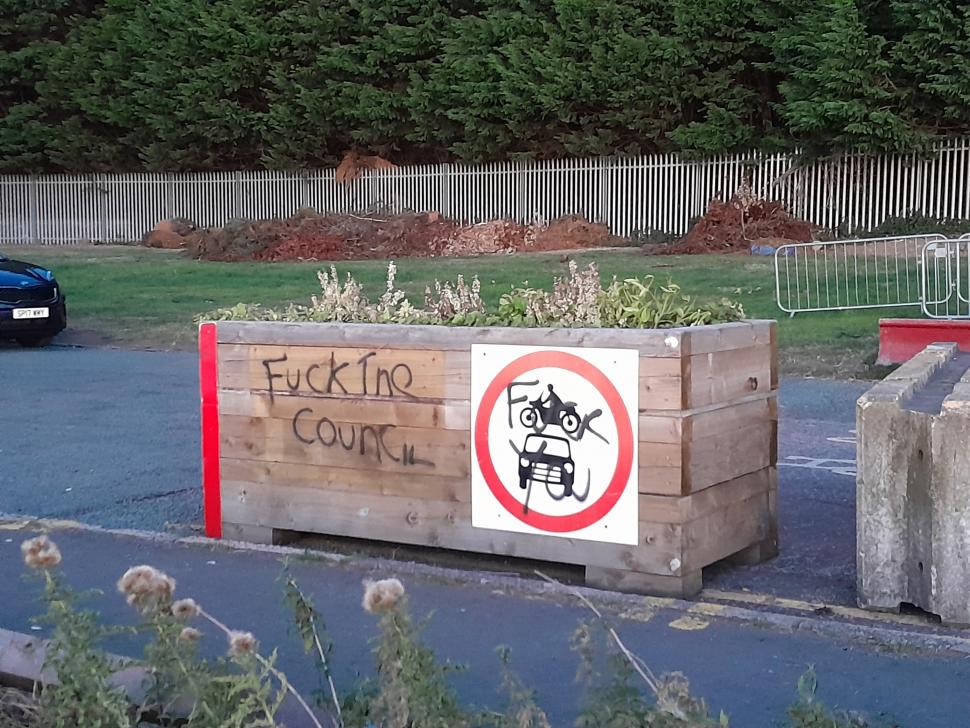

And "what about the old, disabled, children etc who can't park near the shore any more because there are fewer places to park?" and those spaces are all taken by other people in cars, some of whom could have taken the bus or even walked or cycled now that there's (mostly) connected route all the way there (reclaimed from cars).


BalladOfStruth
|
2 years ago
4 likes
Re: Close-passing taxi-driver.
Ah, the good old Ashley Neal "wide angle lens" excuse.
Stop the video at 0:11. A Mini Countryman is 1.8m wide, so using that as a guide, there is maybe a 3m gap between the Mini and the cyclist, with the mini being 30-50cm inside thier lane. Chris then drives his 2.04m wide cab through this gap without crossing the white line, leaving at most 50cm between him and the cyclist.

You can use the TX4 right ahead of him, which according to diagrams is 1480mm between the centres of the rear tyres. That puts the lane at just over 3m.
Then, AIUI the Lime bike has a 26" wheel, which again puts the lane at just over 3m.
Then, someone measured the lane at ~3.25m on Bing maps, so we're all in the right ball-park.
So that's 1m to the *kerb*, yet our genius reckons he left 2m clearance as he passed.


BalladOfStruth
|
2 years ago
10 likes
Even a crap cycle lane is better than no cycle lane at all
Hard disagree. No cycle lane is much better than the sort of cycle lane that endangers a cyclist - this goes double if the offending cycle lane is within good view of the main carriageway so drivers then punish you for not using it.

I live near that junction and to be honest, I'd forgotten there was even a cycle lane there. That's how useful it was. And the pavement did (still does, really) need widening, especially right on the corner by the credit union.
Which isn't to say there haven't been missed opportunities – I'm disappointed that you still can't (legally and/or easily) turn right out of Nine Tree Hill – but I do think replacing that particular painted lane (and let's remember it's not long ago it was fashionable to call it a "moord strip" – not sure if I've spelled that right) with pavement was probably a good decision. Might have been better if they'd made the road one lane only inbound at the same time.
I live near that junction and to be honest, I'd forgotten there was even a cycle lane there. That's how useful it was. And the pavement did (still does, really) need widening, especially right on the corner by the credit union.
Which isn't to say there haven't been missed opportunities – I'm disappointed that you still can't (legally and/or easily) turn right out of Nine Tree Hill – but I do think replacing that particular painted lane (and let's remember it's not long ago it was fashionable to call it a "moord strip" – not sure if I've spelled that right) with pavement was probably a good decision. Might have been better if they'd made the road one lane only inbound at the same time.
I often cycle along Cheltenham Rd and turn down Ashley Rd and the cycle paint was absolutely useless as there'd invariably be taxis parked across it. I tend to use that route late at night, which means that there's drinkers spilling out from the bars and over the cycle lane too. They should just restrict motor vehicles to just one lane along there and have wider pavements and protected cycle lanes too.

I'm usually going straight on and in the daytime, but agree they should reduce it to one lane. It'll be interesting to see if removing the cycle lane will reduce the number of people going straight on from the left-turn lane.
Oh, and I don't mind the drinkers while they're drinking so much, it's early on a weekend morning when they've covered the road in broken glass and discarded nitrous cannisters!
Pages
Latest Comments
- mctrials23 3 min 29 sec ago
Flippin heck!
- quiff 16 min 25 sec ago
To be fair, from the absence of centre line it looks like the road might be too narrow for two vehicles to pass without encroaching on the cycle...
- Rendel Harris 22 min 45 sec ago
As a keen cyclist married to a keen cyclist I can testify that there isn't the slightest comparison. The worst unprovoked comments (i.e. when a row...
- Rendel Harris 1 hour 22 min ago
The UK population is currently a whisker over 69 million. The UK population in the 1901 census was 41 million. When exactly did you start cycling?
- hawkinspeter 1 hour 23 min ago
I think black boxes are great for early detection of cognitive decline and/or sight problems. Someone's driving is going to become much less smooth...
- Bigtwin 1 hour 40 min ago
Taxis doing what they want where they want when they want: unusual...
- Bigtwin 1 hour 59 min ago
It's a fashion. https://guildford-dragon.com/shalford-driver-who-smashed-shalford-war-me...
- MTL Biker 2 hours 20 min ago
Robin Phans .....
- Rendel Harris 4 hours 33 sec ago
Well it would be irresponsible enough if there were only cars and buses, if there are going to be "cars, buses and traffic" that's just suicidal...

